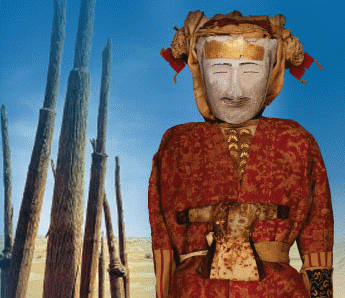

Perhaps an imaginative writer should not view a 3,800 year old beautiful woman. It created a host of images for this Writer but he was certainly not the first to be awed by the "Beauty of Xiaohe. She is the center of attention at Bowers Museum current 'Secrets of the Silk Road exhibition. She is one of three mummies that are part of this exhibition that shows an ancient civilization that flourished in western China and predated the Silk Road by 1,500 years.
These mummies were found in the Tarim Basin, now in Western China, a land with a mostly desert landscape. Of particular interest is the fact that these mummies, hundreds have been discovered, were not buried with mummification as an object. Rather they have been preserved by a unique set of natural circumstances. Scientists believe that a cold climate quickly froze the bodies as they were being buried and a natural freeze-dry process took place. Added favorable conditions are a dry climate and the salty sand in which they were buried. Later the region became the Silk Road and a meeting place where East met West with traders dealing in silks, furs, spices, gold, jade and precious stones.
The Silk Road evolved about the second century B.C. but research has revealed a complex society existed before the Silk Road came into being thanks to the dress and decoration of many of the preserved mummies.
The Bowers Museum exhibition features over 150 objects of this early civilization. One exhibit included familiar Chinese food items like Spring Rolls and Wonton that date back to the seventh century A.D. and examples of these food items have been found with the mummies, also perfectly preserved. As a crossroads for not only material objects but social meetings of many races and cultures authorities estimate that 28 different languages may have been spoken.
The "Beauty of Xiaohe" may be the best preserved mummy ever discovered. One can see her long eyelashes and she does not have oriental features. Her hair is brown with a tint of red. The mummies discovered raise the question who were these people, where did they come from and why did they settle in the harsh region of the Tarim Basin.
As for the Bowers Museum with this exhibition they have done it again. Bowers has a long tradition of exhibiting the world's greatest cultural art. Its own collection includes art of African, Native American and pre-Colombian cultures. Previously we have written about the Terra Cotta warriors exhibition as well as the mummies and burial objects of ancient Egypt. The "Secrets of the Silk Road' exhibition will end on July 25, 2010 at Bowers. The Museum is located at 2002 North Main Street in Santa Ana just off Interstate 5. It is open 10 a.m. to 4 p.m. Tuesday through Friday and 11 a.m. to 4 p.m. on Saturday and Sunday. For more information on admission prices call 714 567-3600. On the web at www.bowers.org.

Graphic Design by Impact Graphics